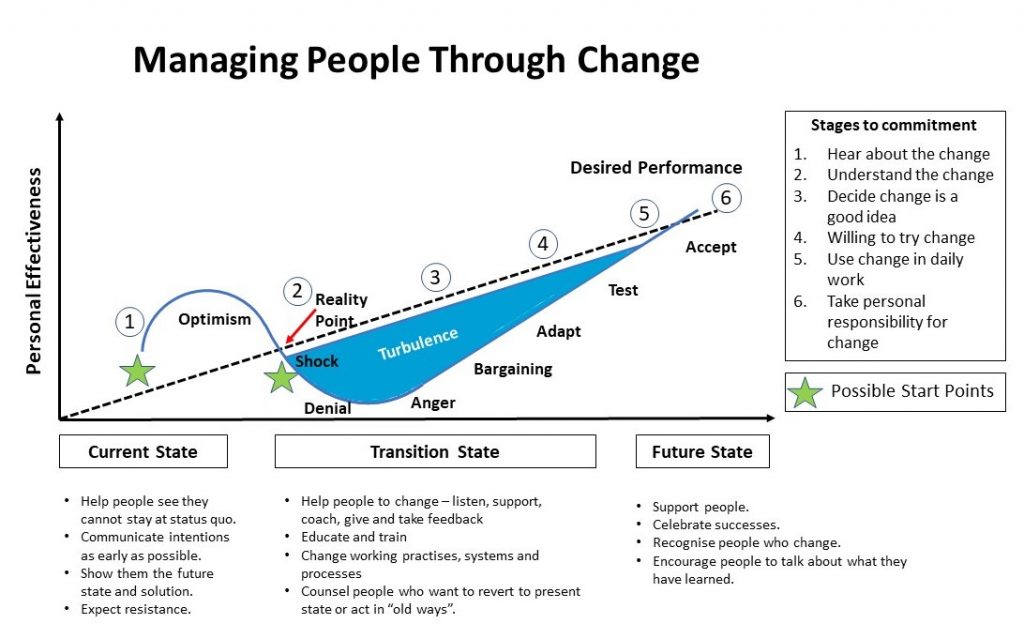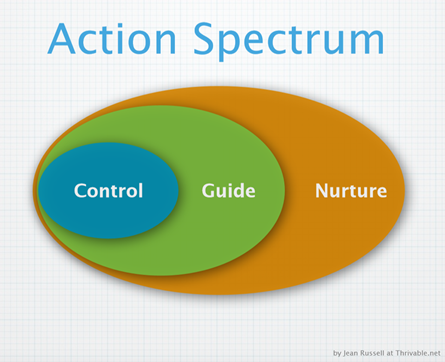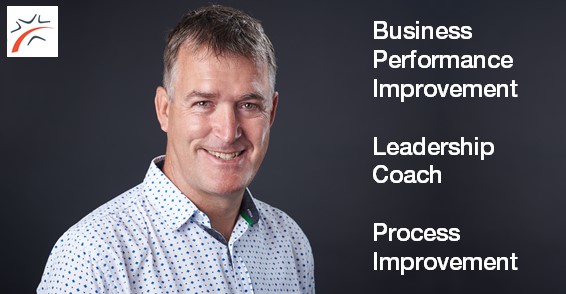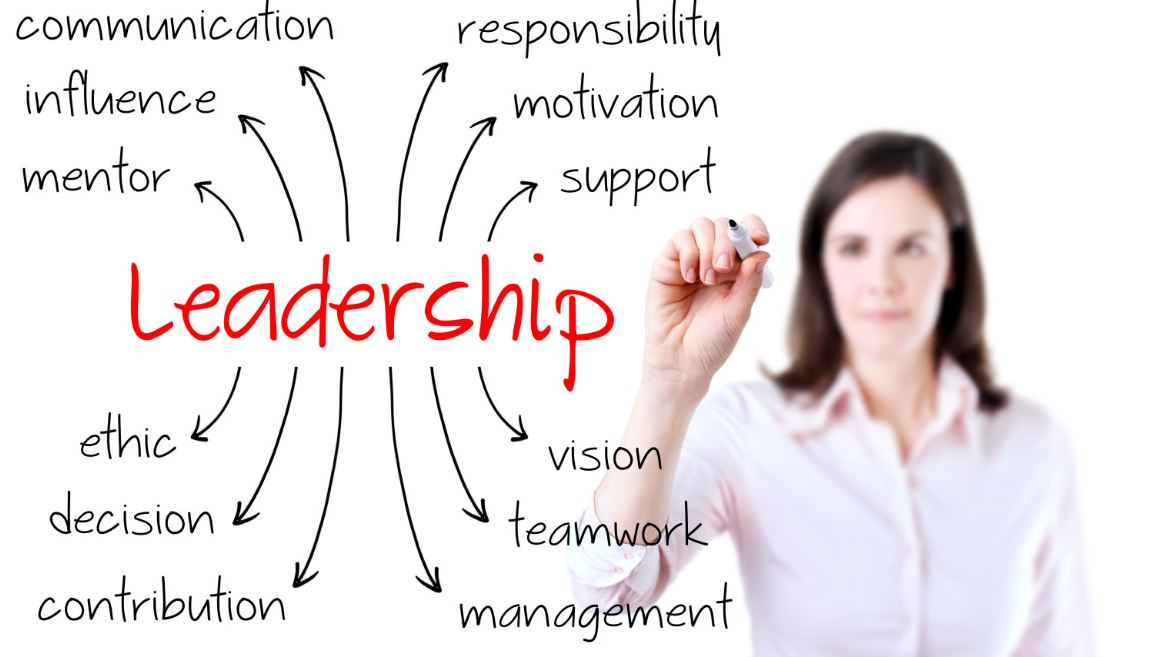Managing People Through Change
Heraclitus, the Greek philosopher said, “Change is the only constant in life.”
At a time when we hope that the rate of change will settle, it seems to be speeding up, with more surprises around every corner.
However, if we take a proactive approach to managing change with our teams, we can help them get to a better place and get used to the fact that change is constant and something we need not fear.
For things to get better, for improvement to take place, this requires change.
In life and in nature, cycles of change happen daily and throughout the seasons.
It’s often not the change itself that makes people nervous and anxious; it’s when change is not anticipated, happens as a surprise or is a shock, that emotions can kick in and make the transition challenging to understand and accept.
As with most things in business and psychology, there are processes that can help us.
The diagram below illustrates very well the roller coaster ride of emotions, understanding, adaptation and ultimately acceptance that can occur for most of us through the process of change.

Our role as leaders, is to help people see that the status quo is not an option, to paint a picture of the future and show a pathway to get there. We must understand that every person is unique and should be allowed to experience their own version of their current reality. This reality is based entirely on their own perceptions, fears, and emotions. We should expect resistance, so be prepared to listen, support and coach people around the obstacles and towards an understanding that the change is a good idea. The grip that fear has on them, will loosen and they will be free to adapt, to try doing things differently and accept that change is good and hopefully, be looking out for opportunities to change more, for the better, in the future.
Remember to share your vision of the future, tell them what your just told them and just when you think you are done, tell them again and accept questions to gain an understanding every step of the way. The aim is to have a team of willing participants reach the future state who are ready to take the next opportunity for change, when they see it.
Ian Featherstone is a cabinetmaker, machinist, business advisor, mentor and leadership coach, and the owner of Glass Half Full. He specialises in the construction industry, particularly the joinery & cabinetry sector. For more information or to find out how you can move your team forward, please visit www.glasshalffull.co.nz
Its more than steering a course – this situation requires Stewardship
March 2022 marks 5 years of writing this column, thank you to Bob, Michael, and Joiners Magazine for the opportunity to share views, stories, and ideas all of you in the industry.
As we move further into 2022, we are sure that the only thing we can be certain of, is more uncertainty and with that the challenges of leading a business forward in unchartered territory once again.
To lead in these times, will require something more, like Stewardship, which can unite, align and bring out the best in your team.
Beware of getting stuck in managing mode
The traditional approach is to create a plan behind closed doors, plotting the course and controlling the flow of work and resources.
Instead, with belief in the life that exists throughout the organisation, a process of invitation and encouragement can be set into motion, connecting people to each other and to their dreams for themselves and for their shared experience of community… revealing hidden gifts and releasing pent-up energy… and cultivating the organisations inherent capability to thrive.
To enable the system to take on a life of its own and to help it become truly self-generative, the challenge of stewardship is to navigate a thoughtful mix of control, guidance, and nurturing; to tend to both individual and collective; and to support the system’s wisdom, learning and enrichment, as well as its accomplishment of tasks and milestones.
Along the way, the wise steward’s questions include: What would bring the most life to this situation? What is the wisdom that is needed now? What seems to want to come to life here? How can I serve this unfolding, either by disturbing things, by planting a seed, by cultivating a freshly sprouted initiative, or by compassionately hospicing something that needs to die?
Stewardship requires thoughtful crafting of structures and systems. It necessarily takes a holistic view — which in organizations means linking purpose with passion, brand with culture, and worker with customer and community.

Management Controls
Management continues to be appropriate for the useful, surface-level busyness of the day-to-day, with its focus on controlling the parts — rather than on the system as a whole — through tactics, action plans, performance goals, and expert-driven solutions in a push to achieve certain, generally known, outcomes.
Leadership Guides
As we shift our focus from efficiency of parts to effectiveness of interactions, leadership becomes the stance of choice. Where patterns of relationship and supportive, connected infrastructure are the primary leverage points, leadership offers guidance (rather than control) through strategies, structures and processes. The leader shapes human dynamics through influence and incentives, as well as through shared values and principles.
Stewardship Nurtures
If our aim is to grow the capability of the system — then we shift from managing the parts and leading for effectiveness to stewarding the health of the whole. Here, control and guidance are replaced by encouragement and invitation, with continuous iteration and attention to evolving patterns of “what wants to happen here?” The goal is not to control, but to create the fertile conditions for something new and unknowable to emerge. The intention is to nurture the system’s intrinsic and ongoing capacity for learning, innovation, self-organization and, ultimately, thriving.
Adapted from an article by Michelle Holiday
If you want to build a ship, don’t drum up people to collect wood and don’t assign them tasks and work, but rather teach them to long for the endless immensity of the sea.
~ Antoine de Saint-Exupery
If you would like to talk in confidence about any of the above or feel the need to reach out, please call me for a no obligation chat (number on website link below)
Ian Featherstone is a cabinetmaker, machinist, business advisor, mentor and leadership coach, and the owner of Glass Half Full. He specialises in the construction industry, particularly the joinery & cabinetry sector. For more information or to find out how you can move your team forward, please visit www.glasshalffull.co.nz
Being fully booked does not make us immune to hard times.
Many of us are pleased to be working in the building industry, at least there is plenty of work, and the outlook for 2022 remains strong.
However, for many people, these last couple of years has taken a toll on our mental health, and there are many people suffering as a result. It’s easy to think that this is just happening to us but remember the Master Joiners slogan; “don’t go it alone”. You are not alone. Reach out for help if you need it.
I have had more contact this year with joiners and cabinetmakers than almost any other year, and whilst firms are “flat out busy”, I see a lot more anxiety, uncertainty, frustration and generally less happiness.
There has also been a productivity drop due to the stop and re-start because of lockdowns. Every time we come back from a long break, it simply takes time to get “back into the groove”. To add to this, our industry has suffered interruptions and re-work from global and local supply chain delays.
Anyone providing joinery to new builds or major renovations will be having a significant % of their installation dates moved out due to delays in building materials, shortage of subcontractors, or further restrictions on site. This creates a never-ending juggling of the plan, and many companies are adjusting schedules daily as a result.
It’s an excellent time to remind ourselves that we can only influence or do something about the things within our control. For many situations, all we can do is communicate appropriately to the affected parties as soon as we know something has changed.
“You can only control what you can control”
Heather O’Reilly
Many things increase costs, impact customer and team satisfaction, and reduce profit.
So, what can we do to minimise the impact and risks of these “happiness and profit hazards”?
- Be realistic; know your capabilities and capacity and plan to this level, allowing a % for job schedule slippage.
- Learn to say no, decide who your “A” customers are, and plan to look after them.
- Reduce complexity and supply risk by specifying reliable products from reputable sources. Simplify designs so that site a measure is either not required or there are less critical measurements required before you can start. Provide full-size templates if necessary, or mark the floor for builders, hold each other to account for accuracy.
- Review your trading terms to allow for larger deposits to cover more materials, reserve the right to change the specification of some items, with consent, when supply impacts your start date or results in additional site visits and extended snag lists.
- Utilise the clause in your t&c’s to increase prices if the quote is past its expiry date, if you don’t have such a clause, get advice, and add it in.
- Consider adding a clause to allow you to use a variation process when extra labour costs will be incurred due to site schedule changes or return to site trips to fit hardware or other items not available at the initial installation time (often items specified by other parties). Talk to your clients about this.
- Review your prices and hourly charge-out rates, make sure you charge for professional services such as design, technical advice or drawings for building consent or client sign off. Don’t just think they are an overhead cost, they are not.
- List Health and Safety compliance in your pricing and if appropriate, disclose this amount to client. These costs have been imposed on you and will ultimately be passed to the consumer.
- When you face a situation where a client requests to delay for a few weeks, and you have no more space for 3-6 months, let them know your situation and that you may not be able to make a firm commitment to a new date if they give up their booking. They may miss out and must wait. Just like what is happening to NZ citizens trying to get a MIQ booking. Let clients know in advance of this potential situation during the sales process.
I wish you all well for the remainder of 2021, a good restful holiday, and a renewed flexible mindset for 2022 and beyond.
If you would like to talk in confidence about any of the above or feel the need to reach out, please call me (number on website link below)
Ian Featherstone is a business advisor, mentor and leadership coach, and the owner of Glass Half Full. He specialises in the construction industry, particularly the joinery & cabinetry sector. For more information or to find out how you can move your team forward, please visit www.glasshalffull.co.nz
Put on your own oxygen mask first
This article has been inspired by two industry events from 2021 and some life events I have heard of and experienced. At the Master Joiners Conference in Hamilton, we were privileged to hear Mike King speak about mental health, in a way only he can do, particularly men’s mental health. The engagement of the audience and the conversations after Mikes presentation demonstrated the underlying awareness, concern and need that exists among us.
In Wellington, at the NKBA conference, Nathan Wallis, a Neuroscience Educator spoke to us about the human brain and how different parts of the brain control our body’s response to the environment and how stressors in life can trigger emotions, neurochemicals, hormones that ultimately affect our behaviour and how to learn and respond to the world around us.
The focus on mental health during the last decade is helping. However, in NZ, too many people still die by suicide. Many others continue to struggle in life with internal challenges, depression, anxiety and stress. However, more people are now receptive to seeking help. I believe we all have a responsibility to recognise and aid this process as appropriate.
As business leaders we often take on more in life than is necessary, sometimes to overload. We think we must be strong and be in control of our emotions.
We rarely take time for ourselves, and we suppress our feelings and emotions and “push on” being tough and continue to “work hard” because that’s what we think we “should do”.
I will summarise one of the concepts from Nathan Wallis: Humans are the only mammals with the ability to have conscious thoughts, apply reason and learn languages and music. This part of our brain (Cortex) is what we use to solve problems, develop relationships, make conscious decisions, train each other, most of the things we aspire to do well at in business. However, suppose the rest of our brain (brainstem), which other animals possess, is activated and we are stressed. In that case, we are essentially in a state of high alert, ready to be triggered into the fight, flight, freeze mode, into anger, violent language or violent behaviour, withdrawal, or to completely freeze.
If humans are in this “stressed mode”, then the brain stem is ruling the moment. The cortex is essentially “turned off”. In this state, logical reasoning, thinking, rational choices, brain development and learning are impossible. So, children and adults in this state cannot respond in the way you think they should. In addition, they cannot absorb, understand, or learn anything at all whilst remaining in this state.
To illustrate, Nathan described a pair of scales, with the brain stem on one side and the cortex on the other; as one increases, the other declines. If the brainstem is activated like the illustration below, then the cortex is essentially turned off.

So how do we practise some form of mind control? You may have noticed your awareness of this already, through publicity and from others who practise some kind of mindfulness, meditation, yoga etc.
You will also notice that schools are educating families on this subject. In some countries, it is already an established daily routine in school and at home.
A great start is to recognise and observe this happening in ourselves and then practise calming our brainstem to achieve a more helpful, healthy state of mind.
With practise, we will develop the ability to show compassion and reasoning and to deal with and lead others in a much more meaningful, helpful, and effective way. The effect on others and the culture of our organisations will be of enormous benefit.
“When angry, count to 10 before you speak. If very angry, a hundred,”
Thomas Jefferson
Conscious breathing, relaxing activities, and some music can calm and decrease brainstem activity and allow a state of clarity to exist. The result will be clearer thinking, control of emotions, and sharp wisdom, ultimately leading to a healthier, fulfilling state of being.
Of course, this takes practice, discipline and making time for yourself and overcoming negative thinking and behaviour that can become barriers to something that is 100% in our control. We already know this, so I challenge you all to make some small change to benefit yourself, then those around you will also benefit.
If we look after ourselves first, we will be in a much better state to do what we wish to do; achieve, train, help others, make a difference, create a great culture, and ultimately be happy.

For more information visit:
https://www.nathanwallis.com/ You can also find lots of videos on his YouTube channel, including many on brain development in early human life.
https://mentalhealth.org.nz/helplines
Ian Featherstone is a business advisor and leadership coach, and the owner of Glass Half Full. He specialises in the construction industry, particularly the joinery & cabinetry sector. For more information or to find out how you can move your team forward, please visit www.glasshalffull.co.nz
COMMUNICATION – WE ARE HUMAN, NOT ROBOTS
In today’s world, it’s easy to become task driven and go from one thing to another and lose sight of what is going on around us. When we feel like this and have so much to do, some of us will become even more focused and be even less aware of what others are doing or what they need from us.
In the last 2 decades, we have become surrounded by more communication devices, channels, systems, and apps, both socially and for business. These all provide an endless stream of information and alerts and disturbances that make it harder and harder for our human mind, which has hardly changed for hundreds, if not thousands of years, to focus, and be happy.
It’s easy to forget that humans are social animals and the best way we send and receive information is face to face, accompanied by gestures and other body language to acknowledge and verify that the message has been understood and received. We are not robots.
Many of us focus on systems, software, machines, processes, KPIs etc to find improvement. The effectiveness of these are multiplied hundreds of times, if good interpersonal communication and leadership is applied as part of the process.
Great leadership question is to ask ourselves are “what is the quality of our communication?” right now? Today? this week? in our business? People like to know where they stand, to get feedback, to be informed, to have clear expectations and to simply have the information they need to do their job. If we work to improve our communication to others, learn to observe ourselves and how others receive, then we have a wonderful opportunity to communicate better, to become a great coach and an effective leader plus be a better person for ourselves, our family and the community.
Key areas to work on at work are, job and team briefings, tool box meetings, company updates and how you might handle issues or crises that arise. Delivering feedback in a constructive way that helps people learn, grow, and be challenged in a positive way.
I would argue that 90% of your customers place more value on the way they are treated, kept informed and handled by your team, than on the products you make.
“I’ve learned that people will forget what you said, people will forget what you did, but people will never forget how you made them feel.”
― Maya Angelou
In the right environment, with the right inputs and energy we can grow ourselves and those around us in a sustainable, agreeable way.
Any good communication requires some planning, shooting from the hip, is sometimes required, however, most of the time, a few moments to think before we speak is much more effective.
Remember, unlike our systems, devices and apps, every person is different and has been programmed differently throughout their life, so understanding them and considering how they might receive, decode and respond to your message, and also how you interpret their response in return completes the cycle and understanding.
For those of use that like diagrams or models, see the one below from Daniela Ilieva-Koleva and Rosaliya Kasamska.






